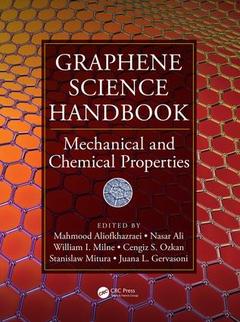Graphene Science Handbook Mechanical and Chemical Properties
Coordonnateurs : Aliofkhazraei Mahmood, Ali Nasar, Milne William I., Ozkan Cengiz S., Mitura Stanislaw, Gervasoni Juana L.

An In-Depth Look at the Outstanding Properties of Graphene
The Graphene Science Handbook is a six-volume set that describes graphene?s special structural, electrical, and chemical properties. The book considers how these properties can be used in different applications (including the development of batteries, fuel cells, photovoltaic cells, and supercapacitors based on graphene) and produced on a massive and global scale.
Volume One: Fabrication Methods
Volume Two: Nanostructure and Atomic Arrangement
Volume Three: Electrical and Optical Properties
Volume Four: Mechanical and Chemical Properties
Volume Five: Size-Dependent Properties
Volume Six: Applications and Industrialization
This handbook describes the fabrication methods of graphene; the nanostructure and atomic arrangement of graphene; graphene?s electrical and optical properties; the mechanical and chemical properties of graphene; the size effects in graphene, characterization, and applications based on size-affected properties; and the application and industrialization of graphene.
Volume four is dedicated to the mechanical and chemical properties of graphene and covers:
- Mechanical properties using a continuum elastic model introduced to describe graphene?s elastic behavior
- Results of theoretical investigations of the mechanical properties of graphene structures
- Mechanical stabilities and properties of graphene under various strains
- Different types of graphene devices for biomolecule and gas sensing
- Printed graphene-based electrochemical sensor technology
- Various types of graphene-based electrochemical sensors
- The chemical vapor deposition of graphene on copper
- Strategies covering graphene modification
- Graphene in solar cells, including transparent electrodes, active layers, and interface layer
- Changes at the micrometric and nanometric scales, and more
MECHANICAL PROPERTIES. CHEMICAL FABRICATION/PROPERTIES. RECENT PROGRESS.
Date de parution : 05-2016
21x28 cm
Thèmes de Graphene Science Handbook :
Mots-clés :
Graphene Sheets; Go; sheets; RGO; oxide; Graphene Nanosheets; chemical; American Chemical Society; vapor; CVD Graphene; deposition; Graphite Oxide; layer; GQDs; bilayers; Monolayer Graphene; graphite; Nanoporous Graphene; highly; Single Layer Graphene; oriented; Graphene Layers; Wavy CNTs; HRTEM Image; Graphene Lms; Solar Cell; Graphene Surface; Pristine Graphene; Diazonium Salt; Armchair Direction; High Order Elastic Constants; Graphene Composite; Van Der Waals; Effective Elastic Properties; Graphene Synthesized



